Biology Short Essay Free Response Questions
10 min read•june 18, 2024
Jessica Nadzam
Jessica Nadzam
Overview of the Short Essay (FRQ) Questions
The AP Biology exam used to consist of eight long-form free response questions, but in 2019 it was redesigned to consist of only six free response questions. Two of those questions are in the “short” form, and these consist of 50% of the free response score, or 25% of your total score.
Long story short, those four questions may not be as long as the first two, but they still pack a big punch on your score.
The short essay questions will always be the last four on your exam. They’re very different than the first two in length and point-value, but you can use the same techniques as the others. You still need to know the content and utilize the “essential verbage” to write an appropriate response, but this response will be shorter and take less time to complete.
You have to write in blue or black ink (for all things that are good, please do not use a pencil), so have a few of your favorite pens ready. You’ll have lots of pages to write on (if you use all of them, you may have written too much), and you’ll be given a copy of the Formulas and Equations Sheet for any calculations you need to do.
Questions are 4 points apiece, and they typically contain content and problems concerning multiple content areas. Since they are shorter they are less likely to cover multiple topics, but it does still happen. You could initially respond about protein structure in the first part and then end up describing the evidence of evolution by the end of the question. There’s a lot of points on the table, and CollegeBoard will make you work for them.
Response Grading (from an AP Reader)
There are 16 points for the last four questions of the FRQ test, and they make up 25% of your AP Biology score. So, how are those points calculated and scored? CollegeBoard is fantastic at writing rigorous questions, but they’re also very good at training their graders (called AP Readers) how to objectively score the questions. Readers spend a whole day training to grade just two of the questions (they don’t get to look at the other four at all), and then spend a whole week grading only those questions, eight hours a day.
A well-oiled machine may be an understatement. The bottom of the line is, AP Readers know exactly what they’re looking for when they’re grading. They read a hundred tests a day (minimum), and if you don’t have the answer they’ve been told is the right answer, they tend to move on pretty quickly.
While this seems intimidating, it’s actually good news for you - but only if you pay very close attention to the next section on verbiage. You see, the bolded verbs in AP free response questions are just hints as to what AP Readers are looking for in an answer. If you know those verbs backwards and forwards, you will know what type of response AP Readers want. And if you know that, you don’t have to worry about writing something that may be right content-wise, but still missing a point on a technicality.
Essential Verbiage
There are a lot of verbs used in AP exams to pose questions for students to ponder and rip their hair out over.
To keep all that hair on your head, we’ve made you a table. It’s pretty easy - if you know exactly what to do when you encounter each bolded verb, you know exactly what to do to answer the question the way the Reader wants to see it. You know how many points it’s worth, and therefore can figure out how much time to spend on it.
Side note - keep in mind that if a question asks you do something more than once - maybe to describe two factors or explain three phenomenon, you should multiple that # Points by however many things it expects you to do.
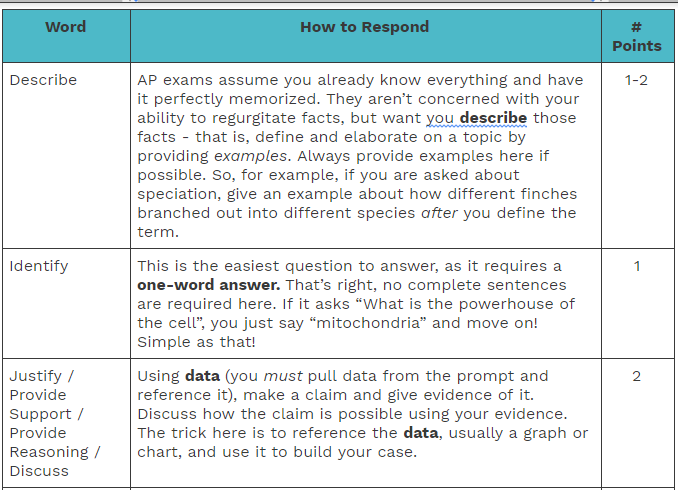
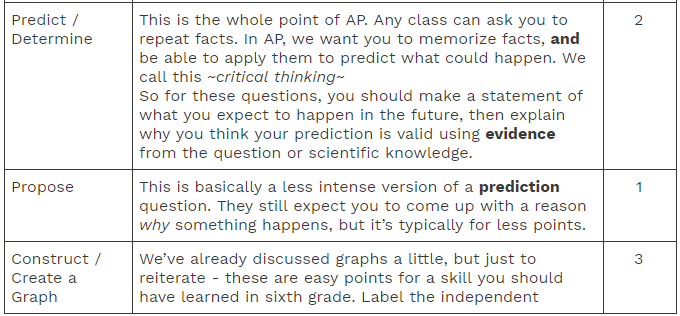
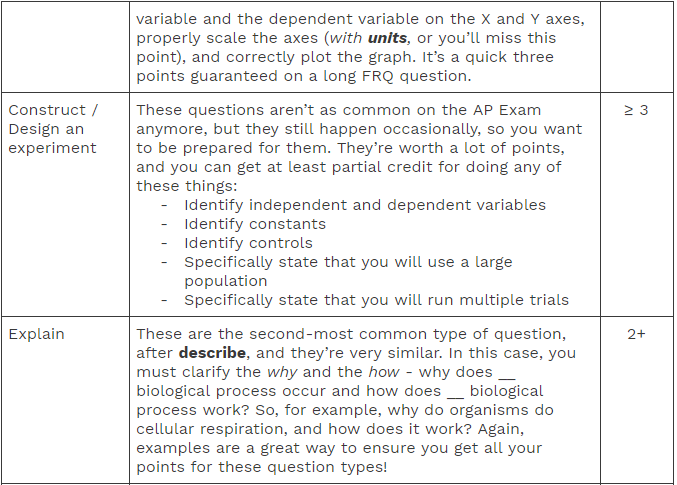
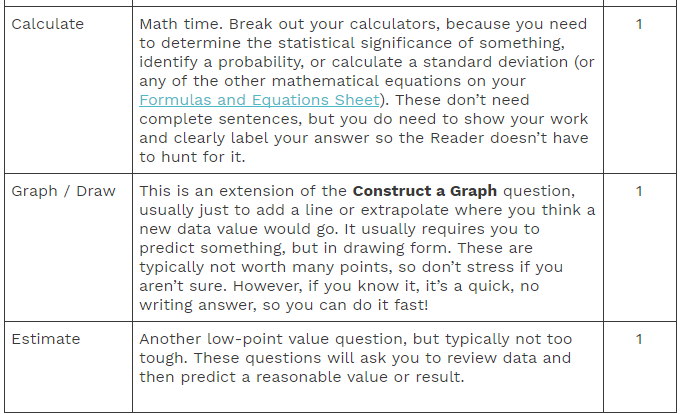
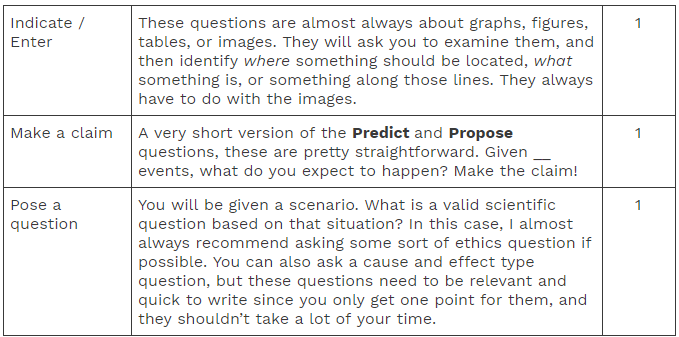
Strategies for 5able Responses
Do you want a 5 on this test? Then here’s what you need to know and be able to do:
- Read. The. Question. Carefully. Seriously. You don’t know how many students miss points because they were skimming and missed a critical word. It’s a heartbreaker for Readers, who want to give you that point, but can’t. Also, read the directions carefully. Your papers always say something about how responses on the actual question page will not be scored. Do not write on the question page. You can use it for brainstorming or outlining as scratch paper, but if your words aren’t written on lined paper or a graph or table, they won’t be scored. So make sure you put your answers in the right place!
- Complete. Sentences. Unless it’s an identify or construct or calculate question, you need a capital letter and a period, or the Reader will not grade that response. Period. Outlines, bulleted lists, and drawings won’t be graded unless specified in the question’s directions.
- Circle your bolded verbs. Find them. Figure out which are worth the most points, the least points, will take the longest, will be the quickest, etc. Then, figure out which ones to answer first.
- When you start the test, you don’t have to go in order. If your mind goes blank on question one, skip it. It’s not going anywhere, you can come back to it. But don’t waste time on it when there are others you can definitely answer later in the booklet.
- The identify and graph/draw questions are some of the quickest to respond to because they don’t require complete sentences, and the answers are usually very quick to come up with. Answer these questions first to get them out of the way.
- Time yourself. You get 90 minutes, but it goes by fast. Keep a digital watch that does not beep, and refer to it regularly. Plot how long you want to spend on each question so you don’t waste time in one area and lose points on another question you could have easily answered. Since the short questions are worth half your free-response score, you shouldn’t spend any more than 45 minutes on these four questions, or about 10-11 minutes apiece.
- This is not AP English. The graders are not English teachers. They don’t care how pretty your introduction is or how
thought-provokingyour thesis statement is. They just want to finish your paper and move on, so don’t ramble on and on. Skip the fluff and go straight to the point. Don’t restate the question or introduce the topic or regurgitate random knowledge - it won’t get you extra points, it’s a waste of time for you, and the Readers get bored sorting through all your thoughts and writing. - Label your responses. While you still have to write in complete sentences, please label each response with a, b, c, etc. if the essay question has multiple parts. You don’t even have to go in order, but this helps Readers find your answer so they don’t have to sift and guess what you meant.
- COMMIT TO YOUR ANSWER. Readers don’t like wishy-washy papers. Erase the words “might” and “possible” and “I think” from your vocabulary. You could be completely wrong, but if you’re writing about a purple hippopotamus, COMMIT to that purple hippopotamus. Don’t say “I think the purple hippopotamus might possibly maybe do photosynthesis if it feels like it.” That’s wishy washy, and Readers don’t accept that as an actual answer, so they won’t give points for it. Be committed, and loudly proclaim “This purple hippopotamus does photosynthesis!” Ta-da!
- If possible, always give an example. We said earlier not to mind dump and regurgitate, but examples are usually a good way to sweep up an extra point or two if you have budgeted your time wisely and can accurately apply it to the scenario. So, now that you know what the Readers are looking for in your responses, let’s talk about the types of questions they will ask you.
Question Types
The short version of the free-response test has four questions, and each of those four questions has a distinct question type. These are based on “science practices” that CollegeBoard expects students to develop to be more well-rounded and critical thinkers. Luckily, these questions go in a distinct order, too. Those types and order is as follows:
- Scientific Investigation
- Conceptual Analysis
- Analysis of Model or Visual Representation
- Analysis of Data With this, you can get a good idea of what to expect on the 3rd, 4th, 5th, and 6th question. And if you’re used to studying for the science section of the ACT, you probably recognize these question types. It’s all about analyzing graphs and tables, pulling information from passages, and performing analysis on data.
Oh, while remembering all that AP Biology knowledge your teacher tried to get into your brain for the past 6-9 months. No pressure.
Let’s break down what each of those question types is asking for, and the best ways to respond to maximize your time and your points.
- Scientific Analysis - this question will describe a lab experiment scenario, and expect you to be able to describe the biological concept or process involved, identify an experimental procedure, predict results, and justify your prediction.
- Conceptual Analysis - in this question, CollegeBoard will present a question that describes a real-life scenario. It will relate that scenario to a biological phenomenon and tell you something has disrupted the process. To get all four points, you will have to describe the biological process that is happening, explain that biological concept, predict the causes and effects of the disruption, and justify your prediction.
- Analysis of Model or Visual Representation may seem like two separate question types, but they will ask you to do the same thing. Both will give you a description of some biological scenario with a visual model. You will be asked to analyze that model, and then describe different biological characteristics of the model, explain the relationships between the different characteristics, identify or draw the relationships within that model, and then explain how the scenario relates to a larger idea or concept.
- Analysis of Data - for the final question of the exam (and then you’re freeeeee!), you will receive data on a graph or table. You will then have to describe the data (twice), evaluate a hypothesis or prediction using the data, and then explain how the experimental results relate to some biological concept. These descriptions can seem a bit confusing on their own. Therefore, some examples are provided below.
Sample Question 1 - Scientific Investigation
A forest ecosystem has a delicate balance of life. Autotrophs, heterotrophs, and decomposers live together and exchange resources to survive. Sometimes their relationships are mutually beneficial, but sometimes they can be harmful for one species and beneficial for another. Buteo jumaicensis, or the red-tailed hawk, consumes smaller organisms such as small reptiles and small mammals. Recently, the ecosystem has been disturbed by deforestation of pine trees. Hawks typically roost on the crowns of tall trees, and as a result their habitat begins to diminish.
a) Describe the niche of the red-tailed hawk.
b) Identify the type of relationship shared between the red-tailed hawk and a common forest mouse.
c) Predict the short-term impact of the decline of the red-tailed hawk due to deforestation, and how it will impact the rest of the ecosystem.
d) Provide reasoning to justify your prediction.
Sample Question 2 - Conceptual Analysis
The lac operon model is a common phenomenon used to demonstrate the regulation of gene expression. In this model, a gene is essentially turned “on” and “off” to produce proteins only when they are necessary. This allows a bacteria called Escherichia coli (E. coli) to metabolize lactose.
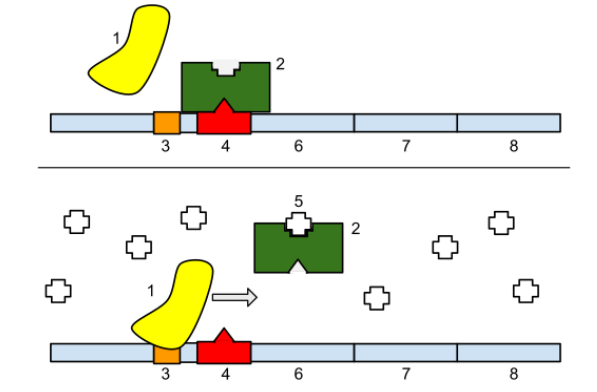
a) Describe the gene expression process from DNA to protein.
b) Explain why operons are an evolutionary advantage over allowing genes to undergo transcription and translation constantly.
c) Although less commonly used for demonstration, the trp operon is another bacterial operon found in E. coli. Predict what would occur if a lac repressor was used on the trp operon.
d) Provide evidence to support your prediction.
Sample Question 3 - Analyze Model or Visual Representation
Signal transduction pathways occur when cells receive signals from outside their membranes, and transduct those messages through the cell to a predetermined location. These signals are used for a variety of reasons including growth, division, mating, protein production, and more. In order for a cell to experience signal transduction, it must receive some signal that binds to a receptor and triggers the pathway.

a) Referring to the figure, predict a possible response that may occur as a result of this signal. b) Describe the steps of the signal transduction pathway that must occur to elicit a response.
c) Sometimes secondary messengers may enter the cell only after a ligand has bound to a receptor. Explain why secondary messengers may be necessary for cell signalling.
d) Identify the ligand in the figure.
<< Hide Menu
Biology Short Essay Free Response Questions
10 min read•june 18, 2024
Jessica Nadzam
Jessica Nadzam
Overview of the Short Essay (FRQ) Questions
The AP Biology exam used to consist of eight long-form free response questions, but in 2019 it was redesigned to consist of only six free response questions. Two of those questions are in the “short” form, and these consist of 50% of the free response score, or 25% of your total score.
Long story short, those four questions may not be as long as the first two, but they still pack a big punch on your score.
The short essay questions will always be the last four on your exam. They’re very different than the first two in length and point-value, but you can use the same techniques as the others. You still need to know the content and utilize the “essential verbage” to write an appropriate response, but this response will be shorter and take less time to complete.
You have to write in blue or black ink (for all things that are good, please do not use a pencil), so have a few of your favorite pens ready. You’ll have lots of pages to write on (if you use all of them, you may have written too much), and you’ll be given a copy of the Formulas and Equations Sheet for any calculations you need to do.
Questions are 4 points apiece, and they typically contain content and problems concerning multiple content areas. Since they are shorter they are less likely to cover multiple topics, but it does still happen. You could initially respond about protein structure in the first part and then end up describing the evidence of evolution by the end of the question. There’s a lot of points on the table, and CollegeBoard will make you work for them.
Response Grading (from an AP Reader)
There are 16 points for the last four questions of the FRQ test, and they make up 25% of your AP Biology score. So, how are those points calculated and scored? CollegeBoard is fantastic at writing rigorous questions, but they’re also very good at training their graders (called AP Readers) how to objectively score the questions. Readers spend a whole day training to grade just two of the questions (they don’t get to look at the other four at all), and then spend a whole week grading only those questions, eight hours a day.
A well-oiled machine may be an understatement. The bottom of the line is, AP Readers know exactly what they’re looking for when they’re grading. They read a hundred tests a day (minimum), and if you don’t have the answer they’ve been told is the right answer, they tend to move on pretty quickly.
While this seems intimidating, it’s actually good news for you - but only if you pay very close attention to the next section on verbiage. You see, the bolded verbs in AP free response questions are just hints as to what AP Readers are looking for in an answer. If you know those verbs backwards and forwards, you will know what type of response AP Readers want. And if you know that, you don’t have to worry about writing something that may be right content-wise, but still missing a point on a technicality.
Essential Verbiage
There are a lot of verbs used in AP exams to pose questions for students to ponder and rip their hair out over.
To keep all that hair on your head, we’ve made you a table. It’s pretty easy - if you know exactly what to do when you encounter each bolded verb, you know exactly what to do to answer the question the way the Reader wants to see it. You know how many points it’s worth, and therefore can figure out how much time to spend on it.
Side note - keep in mind that if a question asks you do something more than once - maybe to describe two factors or explain three phenomenon, you should multiple that # Points by however many things it expects you to do.





Strategies for 5able Responses
Do you want a 5 on this test? Then here’s what you need to know and be able to do:
- Read. The. Question. Carefully. Seriously. You don’t know how many students miss points because they were skimming and missed a critical word. It’s a heartbreaker for Readers, who want to give you that point, but can’t. Also, read the directions carefully. Your papers always say something about how responses on the actual question page will not be scored. Do not write on the question page. You can use it for brainstorming or outlining as scratch paper, but if your words aren’t written on lined paper or a graph or table, they won’t be scored. So make sure you put your answers in the right place!
- Complete. Sentences. Unless it’s an identify or construct or calculate question, you need a capital letter and a period, or the Reader will not grade that response. Period. Outlines, bulleted lists, and drawings won’t be graded unless specified in the question’s directions.
- Circle your bolded verbs. Find them. Figure out which are worth the most points, the least points, will take the longest, will be the quickest, etc. Then, figure out which ones to answer first.
- When you start the test, you don’t have to go in order. If your mind goes blank on question one, skip it. It’s not going anywhere, you can come back to it. But don’t waste time on it when there are others you can definitely answer later in the booklet.
- The identify and graph/draw questions are some of the quickest to respond to because they don’t require complete sentences, and the answers are usually very quick to come up with. Answer these questions first to get them out of the way.
- Time yourself. You get 90 minutes, but it goes by fast. Keep a digital watch that does not beep, and refer to it regularly. Plot how long you want to spend on each question so you don’t waste time in one area and lose points on another question you could have easily answered. Since the short questions are worth half your free-response score, you shouldn’t spend any more than 45 minutes on these four questions, or about 10-11 minutes apiece.
- This is not AP English. The graders are not English teachers. They don’t care how pretty your introduction is or how
thought-provokingyour thesis statement is. They just want to finish your paper and move on, so don’t ramble on and on. Skip the fluff and go straight to the point. Don’t restate the question or introduce the topic or regurgitate random knowledge - it won’t get you extra points, it’s a waste of time for you, and the Readers get bored sorting through all your thoughts and writing. - Label your responses. While you still have to write in complete sentences, please label each response with a, b, c, etc. if the essay question has multiple parts. You don’t even have to go in order, but this helps Readers find your answer so they don’t have to sift and guess what you meant.
- COMMIT TO YOUR ANSWER. Readers don’t like wishy-washy papers. Erase the words “might” and “possible” and “I think” from your vocabulary. You could be completely wrong, but if you’re writing about a purple hippopotamus, COMMIT to that purple hippopotamus. Don’t say “I think the purple hippopotamus might possibly maybe do photosynthesis if it feels like it.” That’s wishy washy, and Readers don’t accept that as an actual answer, so they won’t give points for it. Be committed, and loudly proclaim “This purple hippopotamus does photosynthesis!” Ta-da!
- If possible, always give an example. We said earlier not to mind dump and regurgitate, but examples are usually a good way to sweep up an extra point or two if you have budgeted your time wisely and can accurately apply it to the scenario. So, now that you know what the Readers are looking for in your responses, let’s talk about the types of questions they will ask you.
Question Types
The short version of the free-response test has four questions, and each of those four questions has a distinct question type. These are based on “science practices” that CollegeBoard expects students to develop to be more well-rounded and critical thinkers. Luckily, these questions go in a distinct order, too. Those types and order is as follows:
- Scientific Investigation
- Conceptual Analysis
- Analysis of Model or Visual Representation
- Analysis of Data With this, you can get a good idea of what to expect on the 3rd, 4th, 5th, and 6th question. And if you’re used to studying for the science section of the ACT, you probably recognize these question types. It’s all about analyzing graphs and tables, pulling information from passages, and performing analysis on data.
Oh, while remembering all that AP Biology knowledge your teacher tried to get into your brain for the past 6-9 months. No pressure.
Let’s break down what each of those question types is asking for, and the best ways to respond to maximize your time and your points.
- Scientific Analysis - this question will describe a lab experiment scenario, and expect you to be able to describe the biological concept or process involved, identify an experimental procedure, predict results, and justify your prediction.
- Conceptual Analysis - in this question, CollegeBoard will present a question that describes a real-life scenario. It will relate that scenario to a biological phenomenon and tell you something has disrupted the process. To get all four points, you will have to describe the biological process that is happening, explain that biological concept, predict the causes and effects of the disruption, and justify your prediction.
- Analysis of Model or Visual Representation may seem like two separate question types, but they will ask you to do the same thing. Both will give you a description of some biological scenario with a visual model. You will be asked to analyze that model, and then describe different biological characteristics of the model, explain the relationships between the different characteristics, identify or draw the relationships within that model, and then explain how the scenario relates to a larger idea or concept.
- Analysis of Data - for the final question of the exam (and then you’re freeeeee!), you will receive data on a graph or table. You will then have to describe the data (twice), evaluate a hypothesis or prediction using the data, and then explain how the experimental results relate to some biological concept. These descriptions can seem a bit confusing on their own. Therefore, some examples are provided below.
Sample Question 1 - Scientific Investigation
A forest ecosystem has a delicate balance of life. Autotrophs, heterotrophs, and decomposers live together and exchange resources to survive. Sometimes their relationships are mutually beneficial, but sometimes they can be harmful for one species and beneficial for another. Buteo jumaicensis, or the red-tailed hawk, consumes smaller organisms such as small reptiles and small mammals. Recently, the ecosystem has been disturbed by deforestation of pine trees. Hawks typically roost on the crowns of tall trees, and as a result their habitat begins to diminish.
a) Describe the niche of the red-tailed hawk.
b) Identify the type of relationship shared between the red-tailed hawk and a common forest mouse.
c) Predict the short-term impact of the decline of the red-tailed hawk due to deforestation, and how it will impact the rest of the ecosystem.
d) Provide reasoning to justify your prediction.
Sample Question 2 - Conceptual Analysis
The lac operon model is a common phenomenon used to demonstrate the regulation of gene expression. In this model, a gene is essentially turned “on” and “off” to produce proteins only when they are necessary. This allows a bacteria called Escherichia coli (E. coli) to metabolize lactose.

a) Describe the gene expression process from DNA to protein.
b) Explain why operons are an evolutionary advantage over allowing genes to undergo transcription and translation constantly.
c) Although less commonly used for demonstration, the trp operon is another bacterial operon found in E. coli. Predict what would occur if a lac repressor was used on the trp operon.
d) Provide evidence to support your prediction.
Sample Question 3 - Analyze Model or Visual Representation
Signal transduction pathways occur when cells receive signals from outside their membranes, and transduct those messages through the cell to a predetermined location. These signals are used for a variety of reasons including growth, division, mating, protein production, and more. In order for a cell to experience signal transduction, it must receive some signal that binds to a receptor and triggers the pathway.

a) Referring to the figure, predict a possible response that may occur as a result of this signal. b) Describe the steps of the signal transduction pathway that must occur to elicit a response.
c) Sometimes secondary messengers may enter the cell only after a ligand has bound to a receptor. Explain why secondary messengers may be necessary for cell signalling.
d) Identify the ligand in the figure.

© 2025 Fiveable Inc. All rights reserved.